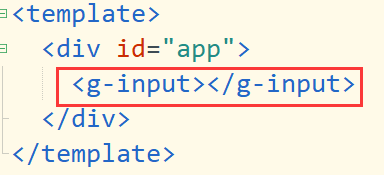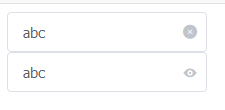封装input组件
组件参数及事件
参数支持:
| 参数名称 | 参数描述 | 参数类型 | 默认值 |
|---|---|---|---|
| placeholder | 占位符 | string | 无 |
| type | 文本框类型(text/password) | string | text |
| disabled | 禁用 | boolean | false |
| clearable | 是否显示清空按钮 | boolean | false |
| show-password | 是否显示密码切换按钮 | boolean | false |
| name | name属性 | string | 无 |
事件支持:
| 事件名称 | 事件描述 |
|---|---|
| blur | 失去焦点事件 |
| change | 内容改变事件 |
| focus | 获取焦点事件 |
基本结构
第一步:在components目录下创建一个input.vue
<template>
<div class="g-input">
<input type="text" class="g-input_inner">
</div>
</template>
<script>
export default {
name: 'GInput'
}
</script>
<style>
</style>
第二步:接着在main.js中进行全局注册

第三步:最后就是在App.vue中进行调用了

第四步:浏览器查看效果
![]()
其中input.vue组件的CSS样式如下:
.g-input {
width: 100%;
position: relative;
font-size: 14px;
display: inline-block;
.g-input_inner {
-webkit-appearance: none;
background-color: #fff;
background-image: none;
border: 1px solid #dcdfe6;
border-radius: 4px;
box-sizing: border-box;
color: #606266;
display: inline-block;
font-size: inherit;
height: 40px;
line-height: 40px;
outline: none;
padding: 0 15px;
transition: border-color .2s cubic-bezier(.645, 045, .355, 1);
width: 100%;
&:focus {
outline: none;
border-color: #409eff;
}
// input禁用样式
&.is-disabled {
background-color: #f5f7fa;
border-color: #e4e7ed;
color: #c0c4cc;
cursor: not-allowed;
}
}
}
placeholder属性
第一步:父组件传值

第二步:子组件接收值并进行校验

第三步:子组件将接收到的值绑定到g-input的属性上

第四步:浏览器查看

type属性
第一步:父组件传值

第二步:子组件接收传过来的值并进行校验

如果不是password类型,则默认为text类型。
第三步:绑定属性

去掉了默认的type="text",采用绑定的形式
第四步:浏览器查看效果

name属性
第一步:父组件传值

第二步:子组件通过props接收值,并进行校验

第三步:子组件绑定属性

disabled属性
第一步:父组件传值

第二步:子组件通过props接收值并进行校验

第三步:子组件绑定属性值

第四步:注意,还要设置当input处于disabled状态下的CSS样式

其中样式为:
// input禁用样式
&.is-disabled {
background-color: #f5f7fa;
border-color: #e4e7ed;
color: #c0c4cc;
cursor: not-allowed;
}
第五步:查看效果

v-model实现双向绑定
当我们给一个input标签进行双向数据绑定时,我们需要使用value绑定数据,再使用input事件监听标签内数据的变动,如下:
<input :value="username" @input="username=$event.target.value"/>第一步:父组件使用v-model绑定

第二步:子组件接收value值

第三步:子组件绑定属性和input事件

第四步:绑定事件回调

clearable属性和show-password属性
clearable允许通过叉图标清空输入框内容。
show-password允许密码框显示密码内容。
第一步:父组件传值

第二步:子组件通过props接收值

第三步:将值绑定到子组件的属性上

第四步:绑定事件

第五步:设置图标的样式
.g-input_suffix {
.g-input_inner {
padding-right: 30px;
}
.g-input_suffix {
position: absolute;
right: 10px;
height: 100%;
top: 0;
line-height: 40px;
text-align: center;
color: #c0c4cc;
transition: all .3s;
z-index: 900;
i {
color: #c0c4cc;
font-size: 14px;
cursor: pointer;
transition: color .2s cubic-bezier(.645, .045, .355, 1);
}
}
}第六步:浏览器查看

完整代码
input.vue组件完整代码
<template>
<div class="g-input" :class="{'g-input_suffix': showSuffix}">
<input class="g-input_inner"
:class="{'is-disabled': disabled}"
:placeholder="placeholder"
:type="showPassword ? (passwordVisible ? 'text' : 'password') : type"
:name="name"
:disabled="disabled"
:value="value"
@input="handleInput"
>
<span class="g-input_suffix">
<i class="iconfont icon-cha" v-if="clearable && value" @click="clear"></i>
<i class="iconfont icon-iconfontordinaryliulan" v-if="showPassword && type=='password'" @click="handlePassword"></i>
</span>
</div>
</template>
<script>
export default {
name: 'GInput',
props: {
placeholder: {
type: String,
default: ''
},
type: {
type: String,
default: 'text'
},
name: {
type: String,
default: ''
},
disabled: {
type: Boolean,
default: false
},
value: {
type: String,
default: ''
},
clearable: {
type: Boolean,
default: false
},
showPassword: {
type: Boolean,
default: false
}
},
data () {
return {
// 显示是否显示密码框
passwordVisible: false
}
},
computed: {
showSuffix () {
return this.clearable || this.showPassword
}
},
methods: {
// 绑定input事件进行回调
handleInput (e) {
this.$emit('input', e.target.value)
},
clear () {
this.$emit('input', '')
},
handlePassword () {
this.passwordVisible = !this.passwordVisible
}
}
}
</script>
<style lang="less" scoped="scoped">
.g-input {
width: 100%;
position: relative;
font-size: 14px;
display: inline-block;
.g-input_inner {
-webkit-appearance: none;
background-color: #fff;
background-image: none;
border: 1px solid #dcdfe6;
border-radius: 4px;
box-sizing: border-box;
color: #606266;
display: inline-block;
font-size: inherit;
height: 40px;
line-height: 40px;
outline: none;
padding: 0 15px;
transition: border-color .2s cubic-bezier(.645, 045, .355, 1);
width: 100%;
&:focus {
outline: none;
border-color: #409eff;
}
// input禁用样式
&.is-disabled {
background-color: #f5f7fa;
border-color: #e4e7ed;
color: #c0c4cc;
cursor: not-allowed;
}
}
}
.g-input_suffix {
.g-input_inner {
padding-right: 30px;
}
.g-input_suffix {
position: absolute;
right: 10px;
height: 100%;
top: 0;
line-height: 40px;
text-align: center;
color: #c0c4cc;
transition: all .3s;
z-index: 900;
i {
color: #c0c4cc;
font-size: 14px;
cursor: pointer;
transition: color .2s cubic-bezier(.645, .045, .355, 1);
}
}
}
</style>
App.vue父组件调用input组件的代码如下:
<template>
<div id="app">
<div>
<g-input placeholder="请输入内容" v-model="useranem" clearable></g-input>
</div>
<div>
<g-input placeholder="请输入内容" v-model="useranem" type="password" showPassword></g-input>
</div>
</div>
</template>
<script>
export default {
data () {
return {
useranem: 'abc'
}
},
methods: {
}
}
</script>
<style lang="scss" scoped>
#app {
.g-input {
width: 200px;
}
}
</style>

